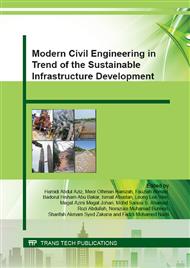[1]
F.U.A. Shaikh, Review of mechanical properties of short fibre reinforced geopolymer composites. Construction and Building Materials, 43 (2013) 37-49.
DOI: 10.1016/j.conbuildmat.2013.01.026
Google Scholar
[2]
C.H. Soares Del Menezzi, V. Gomes de Castro, and M. Rabelo de Souza, Production and properties of a medium density wood-cement boards produced with oriented strands and silica fume. Maderas. Ciencia y tecnología 9, no. 2 (2007) 105-115.
Google Scholar
[3]
H. Kamarudin, Y.M. Liew, A. Mohd Mustafa Al Bakri, M. Luqman, I. Khairul Nizar, and C.Y. Heah, Investigating the possibility of utilization of kaolin and the potential of metakaolin to produce green cement for construction purposes – A review. Australian Journal Basic & Applied Sciences 5, no 9 (2011).
DOI: 10.1016/j.conbuildmat.2011.12.079
Google Scholar
[4]
H.C. Wu, and P. Sun, New building materials from fly ash-based lightweight inorganic polymer. Construction and Building Materials 21, no. 1 (2007) 211-217.
DOI: 10.1016/j.conbuildmat.2005.06.052
Google Scholar
[5]
S. Delair, É. Prud'homme, C. Peyratout, A. Smith, P. Michaud, L. Eloy, E. Joussein, and S. Rossignol, Durability of inorganic foam in solution: The role of alkali elements in the geopolymer network. Corrosion Science 59 (2012): 213-221.
DOI: 10.1016/j.corsci.2012.03.002
Google Scholar
[6]
M. Sofi, J.S.J. Van Deventer, P.A. Mendis and G.C. Lukey, Engineering properties of inorganic polymer concretes (IPCs). Cement and Concrete Research 37, no. 2 (2007) 251-257.
DOI: 10.1016/j.cemconres.2006.10.008
Google Scholar
[7]
S.N. Sarmin, W. Johannes, K. Andreas and S. Ali, Investigating the Possibility of Geopolymer to Produce Inorganic-Bonded Wood Composites for Multifunctional Construction Material–A Review. BioResources 9, no. 4 (2014) 7941-7950.
DOI: 10.15376/biores.9.4.sarmin
Google Scholar
[8]
M.M.A.B. Abdullah, H. Kamarudin, M. Bnhussain, I. Khairul Nizar, Y. Zarina and A.R. Rafiza, Fly ash-based geopolymer lightweight concrete using foaming agent. International journal of molecular sciences 13, no. 6 (2012) 7186-7198.
DOI: 10.3390/ijms13067186
Google Scholar
[9]
Z. Abdollahnejad, F. Pacheco-Torgal, T. Félix, W. Tahri, and J. Barroso Aguiar, Mix design, properties and cost analysis of fly ash-based geopolymer foam. Construction and Building Materials 80 (2015) 18-30.
DOI: 10.1016/j.conbuildmat.2015.01.063
Google Scholar
[10]
J. Davidovits, Geopolymer Chemistry and Applications, 3rd Ed., 2011: Institute Geopolymer, Saint Quentin, France, (2008).
Google Scholar
[11]
F. Gouny, F. Fouchal, O. Pop, P. Maillard and S. Rossignol, Mechanical behavior of an assembly of wood–geopolymer–earth bricks. Construction and Building Materials 38, (2013) 110-118.
DOI: 10.1016/j.conbuildmat.2012.07.113
Google Scholar
[12]
R. Chen, S. Ahmari and L. Zhang, Utilization of sweet sorghum fiber to reinforce fly ash-based geopolymer. Journal of Materials Science 49 no. 6 (2014) 2548-2558.
DOI: 10.1007/s10853-013-7950-0
Google Scholar
[13]
T. Alomayri, F.U.A. Shaikh and I.M. Low, Characterization of cotton fiber-reinforced geopolymer composites. Composites Part B: Engineering 50 (2013) 1-6.
DOI: 10.1016/j.compositesb.2013.01.013
Google Scholar
[14]
Information on https: /geopolymerhouses. wordpress. com/tag/geopolymer-earthbag/page/2.
Google Scholar


